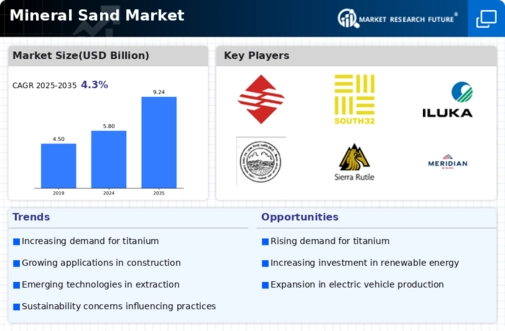Market Trends and Projections
Rising Demand for Titanium Dioxide
The Global Mineral Sand Market Industry experiences a notable increase in demand for titanium dioxide, a key component derived from mineral sands. This demand is largely driven by its extensive use in the production of paints, coatings, and plastics. As industries seek to enhance product quality and durability, titanium dioxide's properties become increasingly desirable. In 2024, the market is projected to reach 5.8 USD Billion, reflecting a growing recognition of titanium dioxide's value. The Global Mineral Sand Market Industry is thus poised for growth, as manufacturers adapt to evolving consumer preferences and regulatory standards.
Technological Advancements in Mining
Technological advancements in mining processes are transforming the Global Mineral Sand Market Industry. Innovations such as automated extraction techniques and enhanced processing methods improve efficiency and reduce operational costs. These advancements not only increase yield but also minimize environmental impact, aligning with global sustainability goals. As companies adopt these technologies, they enhance their competitive edge in the market. The Global Mineral Sand Market Industry is likely to see a positive impact from these developments, as they facilitate the extraction of high-quality mineral sands while adhering to stricter environmental regulations.
Increasing Applications in Electronics
The Global Mineral Sand Market Industry is witnessing a surge in applications within the electronics sector. Mineral sands, particularly those containing zircon and titanium, are utilized in the production of electronic components, including capacitors and semiconductors. As the demand for electronic devices continues to rise, driven by advancements in technology and consumer electronics, the need for high-purity mineral sands becomes critical. This trend indicates a potential for growth in the market, as manufacturers seek reliable sources of these materials to meet production needs. The Global Mineral Sand Market Industry is thus likely to benefit from this expanding application landscape.
Growth in Construction and Infrastructure
The Global Mineral Sand Market Industry benefits from the expanding construction and infrastructure sectors, which utilize mineral sands for various applications. Mineral sands are essential in producing concrete, glass, and ceramics, all of which are integral to modern construction. With urbanization trends continuing to rise, the demand for these materials is expected to increase significantly. This growth is projected to contribute to the market's expansion, with estimates suggesting a rise to 9.24 USD Billion by 2035. The Global Mineral Sand Market Industry is thus positioned to capitalize on this upward trajectory, driven by infrastructure development initiatives worldwide.
Environmental Regulations and Sustainability Initiatives
The Global Mineral Sand Market Industry is increasingly influenced by environmental regulations and sustainability initiatives. Governments worldwide are implementing stricter guidelines to minimize the ecological impact of mining activities. This shift encourages companies to adopt sustainable practices, such as responsible sourcing and waste management. As a result, the industry is likely to see a transformation in operational standards, which may enhance its reputation and marketability. The Global Mineral Sand Market Industry is expected to adapt to these changes, potentially leading to increased investment in sustainable technologies and practices.



















